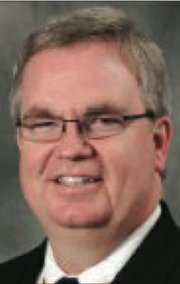Hundreds of lives saved in the city
Jeremy M. Lazarus | 8/5/2016, 7:03 a.m.
In Virginia, more people are dying from drug overdoes than from homicides or traffic accidents, data from state agencies show.
But the situation would be far worse without the availability of a 55-year-old drug called naloxone that is sold under brand names such as Narcan.
Richmond is a prime example of the life-saving impact of the drug that is generally administered as a nasal spray. The city is the epicenter of Virginia’s drug overdose epidemic. Richmond has more deaths from overdoses than any other locality, according to state figures.
In 2015, at least 65 city residents died from opioid poisoning from painkillers like OxyContin and fentanyl and illegal drugs like heroin, according to the state Office of the Chief Medical Examiner.
However, hundreds more city residents were saved because they received timely doses of naloxone, according to the Richmond Ambulance Authority.
The RAA’s emergency medical technicians responding to 911 calls for aid issued 391 doses of naloxone in 2015 to people believed to be suffering from overdoses, said Chip Decker, the RAA’s chief executive officer.
Most of the people survived, he said.
In the first five months of 2016, EMTs and paramedics in Richmond have given naloxone to 265 people in an effort to save their lives, he said.
Had all those people succumbed, deaths from drug overdoses would have eclipsed cancer as the second leading cause of death in Richmond and nearly equaled heart disease, the leading cause of death for city residents.
Mr. Decker said emergency workers are told to give naloxone to anyone who is believed to be suffering a drug overdose. “It can’t hurt,” he said.
Getting people breathing again is a victory for the emergency crews. But for those who are saved and end up in a hospital recovering, naloxone can pack its own horrible punch.
Joseph Hinton, an itinerant construction worker who now lives in Chesterfield County, is among those who have been revived with naloxone.
“I’ve had it about four to five times in my life,” he said.
Now staying in a drug rehab center in his latest effort to kick a heroin addiction, he said he hopes he never experiences naloxone again.
“It’s horrible,” he said of the experience of waking up after getting the drug. “It’s one of the worst withdrawals you ever felt in your life. You feel like you want your high back, almost. You just wanna die, you know. It’s that bad.”
Still, it is one of the few antidotes for overdoses. The drug disrupts the ability of opioids to attach to brain receptors and shut down the respiratory system, according to Mr. Decker. It also can reverse the effect of the opioids by replacing them in the receptors.
The explosion of opioid overdoses has been fueled in part by physicians over-prescribing pain medications that turn patients into addicts and also by a flood of heroin into the country that has made the drug cheaper and easier to obtain.
In Virginia in 2014, drug overdoses claimed 728 lives, compared with 700 deaths from traffic accidents and 337 deaths from homicides, according to state statistics. In the past seven years, deaths statewide from opioid overdoses have climbed from around 500 a year to more than 700. Similar escalation can be found in most other states.
Local, state and national governments look to naloxone to stem the tide of deaths, particularly now that the drug overdoses have spread beyond African-American communities.
In 2015, the Virginia General Assembly ended years of restrictions on naloxone availability, long after other states realized the drug’s importance. Lawmakers finally made it easier for pharmacists to dispense the drug, one of the recommendations that emerged from a task force Gov. Terry McAuliffe set up to seek ways to tackle the sharp increase in opioid deaths.
The goal: To make naloxone more widely available.
The new law allows druggists to collaborate with a doctor on a “standing order” that allows the pharmacist to dispense naloxone without the patient having to see the doctor first — the same arrangement that allows people to get flu shots at drugstores without a prescription.
Pharmacists also are allowed to dispense the drug to people not at risk of overdose themselves but who worry about someone else who could overdose and want the ability to save their life.
State officials said the law actually gives pharmacists broad authority to dispense the drug to anyone who asks.
Still, as Mr. Hinton put it, the high from heroin and other drugs can be so great that it’s hard to beat, even if it means facing another dose of naloxone. That’s why rehab rarely works the first time.
Studies show that recovery attempts are often short-lived, sometimes with and sometimes without professional help. The likelihood that addicts will fall off the wagon is so great that some professionals urge addicts to have a companion or family member nearby who can call for emergency help or who can administer a dose of naloxone.
In the past year, Virginia has begun a pilot project called Revive! aimed at training lay people how to use naloxone and how to train others. So far more than 1,000 people have received the training.
Training is needed because a rescuer must attach an atomizer to the tip of a pre-filled naloxone syringe in order to spray it in a nose.
The Richmond-based Kaléo pharmaceutical company has developed a new option, Evzio, which auto-injects the drug. The company also makes an epinephrine auto-injector for treating severe allergic reactions. However, it is more expensive than the nasal spray.
At the national level, numerous proposals are being rolled out, including making naloxone more widely available, providing addicts alternatives to jail and allowing other medical professionals like nurses to administer anti-addiction drugs.
So far, Congress has passed legislation endorsing the ideas, but has not provided any funding to make them happen.








